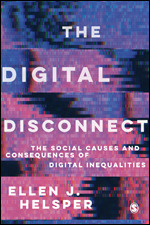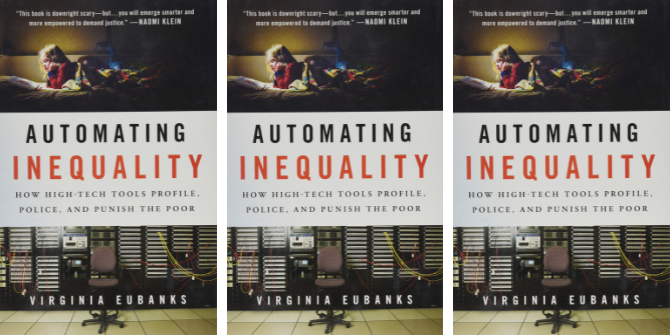In The Digital Disconnect, Ellen Helsper explores how digital and social inequalities are interlinked and what we might do to prevent them. Utilising an intersectional perspective and showing careful attention to the use of language around ICT use, this book offers a useful overview of the key issues relating to socio-digital inequalities and possible solutions, writes Anna Rohmann.
The Digital Disconnect. Ellen Helsper. SAGE Publications. 2021.
 Find this book (affiliate link):
Find this book (affiliate link):![]()
Have you heard of the digital divide? Ever wondered what ‘digital natives’ are and why it’s good to be one? Or why tech moguls like Elon Musk or Bill Gates lead rankings of the richest people on earth? Inequalities in the access and use of technology as well as the benefits of them are hot topics. If some people gain from the use of information and communication technology (ICT), is there something we can do to distribute those benefits more equally? And how does this relate to existing inequalities?
The question of how digital and social inequalities are related and what we might do to prevent them is what Ellen Helsper, Professor of Digital Inequalities at LSE, tackles in her book The Digital Disconnect. To address the interplay and consequences of these inequalities in-depth, she combines qualitative and quantitative data, derived mostly from LSE’s DiSTO project but also from public institutional databases, among them the Organisation for Economic Co-operation and Development (OECD) and the World Bank.
The Digital Disconnect aims to fill a gap in theorisations of socio-digital inequalities where ‘the middle is largely missing. Relatively few scholars incorporate the networks and communities where people live their everyday lives’ (41). Consequently, Helsper narrows in on the meso level (between the micro and the macro) and aims to raise awareness of the social components of our engagement with ICTs and resulting socio-digital inequalities.
In Helsper’s definition, socio-digital inequalities refer to ‘the systematic differences in the ability and opportunity for people to beneficially use (or decide not to use) ICTs, while avoiding negative outcomes of digital engagement now and in the future’ (27). The conceptual focus on inequalities of outcome is convincing as she demonstrates that even with the same opportunities, differences exist that cannot be chalked up to personal merit. Socio-digital inequalities are to be understood as intersectional, with compounding disadvantages that map onto traditional inequality research, as presented in the first chapter.
Unlike a book with a twin name, Digital Disconnect by Robert W. McChesney, this book considers the interplay of inequalities not just from an economic but also from multiple intersecting perspectives. Inspired by Pierre Bourdieu’s three fields of capital (economic, social and cultural), Helsper developed the Corresponding Fields model (CF), putting the fields into relation with their digital counterparts. The CF model includes a fourth site – the personal – as capital reproduction also occurs in private spheres, not just systemic ones. Conscious of the critique of field theories being vague concepts with little practical relevance, Helsper emphasises that they are nevertheless important units of analysis as they illustrate that ‘links between social and digital inequalities are strongest between corresponding domains of offline and digital resources’ (39). The fields with their resources provide the structure for the rest of the book.

Image Credit: Pixabay CCO
Tangible outcomes, like access to digital infrastructure (Chapter Three), digital skills measured in economic values (Chapter Four) and civic (formal and informal) engagement in the digital realm (Chapter Five), have often been the focus of inequalities research. However, Helsper notes that ‘the real issue is the continuation or exacerbation of existing inequalities’ (34), which includes the private, informal sphere, to which Chapters Six and Seven are dedicated. I found these chapters the most illuminating as the informal engagement with ICTs in the private and cultural sphere has received little attention in previous research, which is ‘a grave oversight’ (148).
Helsper makes the argument that it is equally important to understand how inclusion in online communities works to understand how differences in social wellbeing, online mobbing or loneliness affect us. Inequalities in our social relationships online often follow existing lines of stratification, meaning the vulnerable are less likely to have positive experiences and connections online than the already privileged. To address these compounded disadvantages, a multi-stakeholder approach is needed.
A similar picture emerges in cultural sites of content production and consumption. Digital segregation occurs from a positive feedback loop that encourages those who already feel accepted in society to make their voices heard, which ‘may unwittingly silence others, who do not see themselves represented, and who receive negative or no feedback on the content they create’ (177). The long-term consequences of this for our wellbeing and digital future are not yet researched.
Neither systemic approaches targeting neoliberal mindsets or class nor placing responsibility on an individual’s agency and skill can solve inequalities. This leads Helsper to conclude that change needs to happen on a collective level that takes intersectionality, relativity and network effects into account: ‘The lesson learned from sequential and compounded digital inequalities is that first-level (access), second-level (skills and engagement), and third-level (outcome) digital inequalities should always be studied and combatted together’ (180).
Scholars outline four possible scenarios for socio-digital futures in terms of inequalities: amplification (the rich get richer; see developments described in Chapters Six and Seven); stratification (the status quo stays); normalisation (equality is achieved); and leapfrogging (the poor get rich, the rich stay behind). Helsper’s ‘realist-optimist’ (28) view emphasises possible actions and recommendations for curriculums and policymakers, which takes arguments past theoretical thought experiments and provides some hope that we can change our socio-digital futures for the better.
The chapters are neatly organised, dealing with the causes and consequences of socio-digital inequalities by going through all the fields of the CF framework. Following this clear structure makes reading about complex inequalities easier and the use of vignettes illustrates the points driven by quantitative data.
An appealing quality of Helsper’s writing is her careful attention to language. The term ‘socio-digital inequalities’ is deliberately coined to avoid techno- and socio-determinism, which the popular language of ‘the digital divide’ or ‘inequality’ alone can perpetuate. The same applies to the choice of ‘digital engagement’ over ‘ICT use’, reminding us that not using ICTs can also be a privileged form of engagement.
Another strength of The Digital Disconnect is the outcome-focused attention to the meso level and the refreshing intersectional perspective. This is an important step to filling the gap in socio-digital inequalities research, especially since it offers not just theorisations of the problem but also solutions.
Simultaneously, the focus on solutions is one of the book’s weaknesses. Helsper makes the underlying assumption that the reader and ‘victims’ of inequalities see them as undesirable (45) and would want them eradicated no matter the solution, whereas the reality is not as straightforward. An example is Helsper’s proposal for solving inequalities in the digital literacy skills of young people. Conventional approaches focus on teaching hard skills and risks online. Reframing digital skills training to include soft skills is supposed to prevent the ‘negative’ outcome of formal training that ‘slots individuals into gaps’ in the job market. While a balanced approach to education is necessary, filling a niche as ‘workers on a digital factory floor’ (92) might be preferred to being unemployed at a time when economic citizenship carries a lot of weight. The judgment behind what ‘negative’ or ‘positive’ outcomes are, who draws these lines and the categories used for this could be questioned more.
My main point of contention is the data foundation. ICT is a relatively recent phenomenon and fast-moving research environment. Therefore, there is a lack of longitudinal data about many ICT domains, especially its social components, as most studies focus on the Global North with a descriptive, economic outlook. The author tries not to perpetuate the data bias towards the Global North, but reliable, independent research just hasn’t been done yet. While well-grounded in Helsper’s scholarly knowledge, the speculations about the future left me somewhat unsatisfied. If other readers share this feeling, I hope it inspires projects to collect the missing data.
In addition, data is often collected per country; however, ICTs are translocal by definition, meaning they are rooted in local and global digital spheres alike. A new way to measure inequalities in translocal spaces where geographic categories like nation states do not always reflect the experience of participants is needed. Helsper does not problematise these traditional categories and measurements.
All in all, The Digital Disconnect provides a good meso-level analysis of socio-digital inequalities, organised along the lines of the CF framework, and it provokes thought on the nature of research needed. While easy to follow, some familiarity with the inequality literature or an understanding of Helsper’s previous research, which she draws heavily on, might be useful. Therefore, I would recommend this book to everyone interested in a good overview of the emerging literature, key issues and possible solutions to socio-digital inequalities, rather than as an introduction to the completely uninformed reader.
The digital is here to stay, so dealing with socio-digital inequalities will be a task for our future. Concluding with Helsper’s realist-optimist words, ‘the fact that we all play a role in shaping socio-digital environments also means that we can collectively create a more just socio-digital future’ (193).
If you are interested in this book, you can watch a video of an LSE International Inequalities Institute event discussing The Digital Disconnect and you can also watch this LSE Festival 2022 short based on Ellen Helsper’s work on digital inequalities:
Note: This review gives the views of the author, and not the position of the LSE Review of Books blog, or of the London School of Economics and Political Science. The LSE RB blog may receive a small commission if you choose to make a purchase through the above Amazon affiliate link. This is entirely independent of the coverage of the book on LSE Review of Books.







